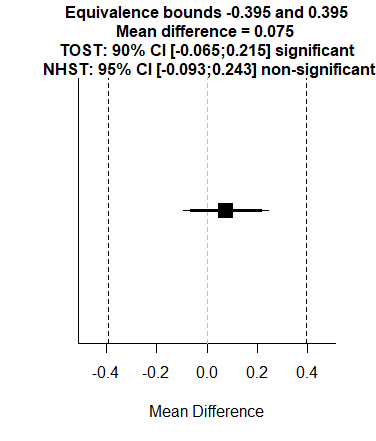The aim of my study is to study the differences between stages of sleep based on the proportion of response when subjects are faced with some stimuli. To begin with I used a classical frequentist approach by fitting a linear mixed model (function lmer in R) with "Sleep_Stages" as the fixed factor and "Subject" as the random factor:
model<-lmer(Response~Sleep_Stages+(1|Subject),data)
I studied the pairwise comparisons and realised that the difference between two groups(Stage2 and Stage5) is not significant:
contrast estimate SE df t.ratio p.value
Stage2- Stage5 0.074 0.0520 109716 1.187 0.4486
This result is very interesting to me, but I can't just conclude that since there is no significant difference between Stage2 and Stage5 that means that Stage2 is equivalent to Stage5, that simply means that the current evidence is not strong enough to persuade me that the two groups lead to different outcomes ("the absence of evidence is not the evidence of absence")... In another word I am not trying to prove that one group makes a statistically significant difference in the outcome. Rather, I am trying to prove that the two groups are essentially equivalent, I've been advice to use an equivalence test using TOST procedure:
m1<-mean(Stage2)
sd1<-sd(Stage2)
n1<-length(Stage2)
m2<-mean(Stage5)
sd2<-sd(Stage5)
n2<-length(Stage5)
library(TOSTER)
> TOSTtwo(m1,m2,sd1,sd2,n1,n2,low_eqbound_d=-1.5,high_eqbound_d=1.5)
TOST results:
t-value lower bound: 5.69 p-value lower bound: 0.000001
t-value upper bound: -3.87 p-value upper bound: 0.0002
degrees of freedom : 32.82
Equivalence bounds (Cohen's d):
low eqbound: -1.5
high eqbound: 1.5
Equivalence bounds (raw scores):
low eqbound: -0.3946
high eqbound: 0.3946
TOST confidence interval:
lower bound 90% CI: -0.065
upper bound 90% CI: 0.215
NHST confidence interval:
lower bound 95% CI: -0.093
upper bound 95% CI: 0.243
Equivalence Test Result:
The equivalence test was significant, t(32.82) = -3.873, p = 0.000242, given equivalence bounds of -0.395 and 0.395 (on a raw scale) and an alpha of 0.05.
Null Hypothesis Test Result:
The null hypothesis test was non-significant, t(32.82) = 0.909, p = 0.370, given an alpha of 0.05.
Based on the equivalence test and the null-hypothesis test combined, we can conclude that the observed effect is statistically not different from zero and statistically equivalent to zero.
So could I conclude now that I have a substantial evidence that the two groups (Stage2 and Stage5) are equivalent?
Can someone help me interpret this results?
(PS: I don't really know how to choose the equivalence bounds..)

